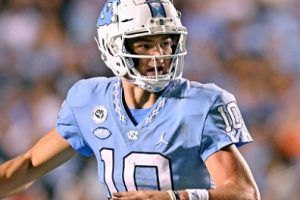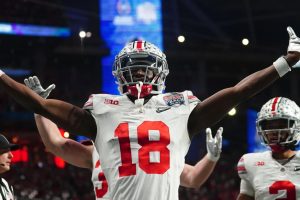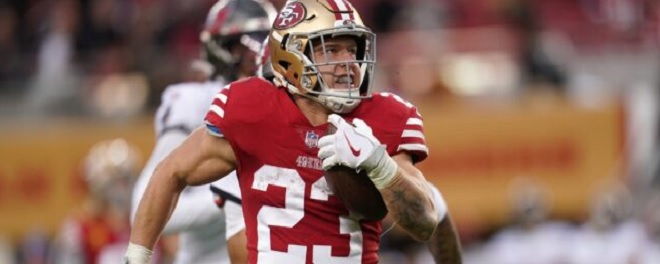There will be many more 2011 Fantasy Football Rankings and features in the late spring and summer, including tons of 2011 Fantasy Football Mock Drafts and Player Rankings. I’ll also have an extensive 2011 NFL Fantasy Football Preseason Stock Report. Follow me @walterfootball for updates.
2011 Fantasy Football – Various League Strategy (July 18):
I’ve received several e-mails from people asking questions like, “How should I adjust your cheat sheet in a two-quarterback league?” or “Should I make changes to your big board if I’m doing a keeper league?”
I’m going to use this page to discuss different kinds of leagues and how you should treat your cheat sheet. As a reference, normal leagues start: 1 QB, 2 RBs, 2 WRs, 1 flex, 1 TE, 1 DEF, 1 K.
2011 Fantasy Football League Strategy – 3 WRs:
I’m in a league that starts two running backs, three receivers and no flex, so I’m very familiar with this format. Last year, I had the option of drafting Frank Gore or Andre Johnson with the fifth pick in the first round. I had Gore ahead of Johnson on my board, but went with the latter because of the three-receiver format. That decision got me into the second round of the playoffs.
I’d recommend moving each receiver up a few slots on your big board. Wideouts become scarce in 3-WR leagues, and you’re much less likely to land a prized free agent receiver because many of them will already be rostered already.
Here’s my current top 30 for 3-WR leagues. Go here to see my regular 2011 Fantasy Football Top 150 Cheat Sheet:
- Arian Foster, RB, Texans. Bye: 11.
- Chris Johnson, RB, Titans. Bye: 6.
- Adrian Peterson, RB, Vikings. Bye: 9.
- Andre Johnson, WR, Texans. Bye: 11.
- Ray Rice, RB, Ravens. Bye: 5.
- Rashard Mendenhall, RB, Steelers. Bye: 11.
- LeSean McCoy, RB, Eagles. Bye: 7.
- Steven Jackson, RB, Rams. Bye: 5.
- Calvin Johnson, WR, Lions. Bye: 9.
- Darren McFadden, RB, Raiders. Bye: 8.
- Aaron Rodgers, QB, Packers. Bye: 8.
- Jamaal Charles, RB, Chiefs. Bye: 6.
- Hakeem Nicks, WR, Giants. Bye: 7.
- Frank Gore, RB, 49ers. Bye: 7.
- LeGarrette Blount, RB, Buccaneers. Bye: 8.
- Matt Forte, RB, Bears. Bye: 5.
- Greg Jennings, WR, Packers. Bye: 8.
- Roddy White, WR, Falcons. Bye: 8.
- Mike Wallace, WR, Steelers. Bye: 11.
- Maurice Jones-Drew, RB, Jaguars. Bye: 9.
- Tom Brady, QB, Patriots. Bye: 7.
- Larry Fitzgerald, WR, Cardinals. Bye: 6.
- Antonio Gates, TE, Chargers. Bye: 6.
- Peyton Manning, QB, Colts. Bye: 11.
- Jonathan Stewart, RB, Panthers. Bye: 9.
- Reggie Wayne, WR, Colts. Bye: 11.
- Mike Williams, WR, Buccaneers. Bye: 8.
- Miles Austin, WR, Cowboys. Bye: 5.
- Ahmad Bradshaw, RB, Giants. Bye: 7.
- Drew Brees, QB, Saints. Bye: 11.
2011 Fantasy Football League Strategy – 2 WRs, no flex:
I’m also in a league that starts two running backs, two receivers and no flex. In this scenario, receivers lose value. I usually refrain from drafting a wideout until Round 4 or so unless an elite receiver falls to me.
Here’s my current top 30 for 2-WR, no flex leagues. Go here to see my regular 2011 Fantasy Football Top 150 Cheat Sheet:
- Arian Foster, RB, Texans. Bye: 11.
- Chris Johnson, RB, Titans. Bye: 6.
- Adrian Peterson, RB, Vikings. Bye: 9.
- Ray Rice, RB, Ravens. Bye: 5.
- Rashard Mendenhall, RB, Steelers. Bye: 11.
- LeSean McCoy, RB, Eagles. Bye: 7.
- Steven Jackson, RB, Rams. Bye: 5.
- Aaron Rodgers, QB, Packers. Bye: 8.
- Darren McFadden, RB, Raiders. Bye: 8.
- Andre Johnson, WR, Texans. Bye: 11.
- Jamaal Charles, RB, Chiefs. Bye: 6.
- Frank Gore, RB, 49ers. Bye: 7.
- LeGarrette Blount, RB, Buccaneers. Bye: 8.
- Matt Forte, RB, Bears. Bye: 5.
- Maurice Jones-Drew, RB, Jaguars. Bye: 9.
- Calvin Johnson, WR, Lions. Bye: 9.
- Tom Brady, QB, Patriots. Bye: 7.
- Hakeem Nicks, WR, Giants. Bye: 7.
- Greg Jennings, WR, Packers. Bye: 8.
- Roddy White, WR, Falcons. Bye: 8.
- Antonio Gates, TE, Chargers. Bye: 6.
- Mike Wallace, WR, Steelers. Bye: 11.
- Peyton Manning, QB, Colts. Bye: 11.
- Jonathan Stewart, RB, Panthers. Bye: 9.
- Ahmad Bradshaw, RB, Giants. Bye: 7.
- Drew Brees, QB, Saints. Bye: 11.
- QB Eagles No. 7, QB, Eagles. Bye: 7.
- Ryan Mathews, RB, Chargers. Bye: 6.
- Peyton Hillis, RB, Browns. Bye: 5.
- Larry Fitzgerald, WR, Cardinals. Bye: 6.
2011 Fantasy Football League Strategy – 2 QBs:
I don’t need to tell you that you need to draft two quarterbacks fairly early in a 2-QB league. There are 32 starting quarterbacks in the NFL, yet there will be 36 of them chosen if all of the teams in your league roster three signal-callers (one as a reserve or bye-week filler). This presents a huge problem if you wait for a quarterback; you’ll have to spend a late-round pick on someone like Jon Kitna, Shaun Hill, Blaine Gabbert or Chad Henne. Blegh.
When drafting, you can probably look at a standard cheat sheet and slice all of the quarterbacks’ rankings by half for 2-QB leagues. For example, if Philip Rivers is 34th on your standard board, he should be around 17th in a 2-QB format.
Here’s my current top 30 for 2-QB leagues. Go here to see my regular 2011 Fantasy Football Top 150 Cheat Sheet:
- Arian Foster, RB, Texans. Bye: 11.
- Chris Johnson, RB, Titans. Bye: 6.
- Adrian Peterson, RB, Vikings. Bye: 9.
- Aaron Rodgers, QB, Packers. Bye: 8.
- Ray Rice, RB, Ravens. Bye: 5.
- Rashard Mendenhall, RB, Steelers. Bye: 11.
- LeSean McCoy, RB, Eagles. Bye: 7.
- Andre Johnson, WR, Texans. Bye: 11.
- Steven Jackson, RB, Rams. Bye: 5.
- Tom Brady, QB, Patriots. Bye: 7.
- Peyton Manning, QB, Colts. Bye: 11.
- Darren McFadden, RB, Raiders. Bye: 8.
- Jamaal Charles, RB, Chiefs. Bye: 6.
- Drew Brees, QB, Saints. Bye: 11.
- Calvin Johnson, WR, Lions. Bye: 9.
- QB Eagles No. 7, QB, Eagles. Bye: 7.
- Frank Gore, RB, 49ers. Bye: 7.
- Philip Rivers, QB, Chargers. Bye: 6.
- Hakeem Nicks, WR, Giants. Bye: 7.
- LeGarrette Blount, RB, Buccaneers. Bye: 8.
- Tony Romo, QB, Cowboys. Bye: 5.
- Matt Forte, RB, Bears. Bye: 5.
- Greg Jennings, WR, Packers. Bye: 8.
- Ben Roethlisberger, QB, Steelers. Bye: 11.
- Maurice Jones-Drew, RB, Jaguars. Bye: 9.
- Roddy White, WR, Falcons. Bye: 8.
- Mike Wallace, WR, Steelers. Bye: 11.
- Antonio Gates, TE, Chargers. Bye: 6.
- Jonathan Stewart, RB, Panthers. Bye: 9.
- Josh Freeman, QB, Buccaneers. Bye: 8.
2011 Fantasy Football League Strategy – Very Deep Leagues (16 or more teams):
I’ve been in several 20-team leagues over the years. It’s tough. If you have, for example, the fifth pick, you don’t go again until No. 36, which would be the final selection in the third round of a 12-teamer.
Since every roster in a 20-team league is going to be very thin, you absolutely can’t afford to pick busts or players who will miss an extensive period of time. Thus, you need to take safe players only unless someone of great value presents himself later than expected.
Here’s my current top 30 for very deep leagues. Go here to see my regular 2011 Fantasy Football Top 150 Cheat Sheet:
- Arian Foster, RB, Texans. Bye: 11.
- Chris Johnson, RB, Titans. Bye: 6.
- Adrian Peterson, RB, Vikings. Bye: 9.
- Ray Rice, RB, Ravens. Bye: 5.
- Rashard Mendenhall, RB, Steelers. Bye: 11.
- LeSean McCoy, RB, Eagles. Bye: 7.
- Andre Johnson, WR, Texans. Bye: 11.
- Aaron Rodgers, QB, Packers. Bye: 8.
- Steven Jackson, RB, Rams. Bye: 5.
- Jamaal Charles, RB, Chiefs. Bye: 6.
- Calvin Johnson, WR, Lions. Bye: 9.
- Hakeem Nicks, WR, Giants. Bye: 7.
- LeGarrette Blount, RB, Buccaneers. Bye: 8.
- Matt Forte, RB, Bears. Bye: 5.
- Tom Brady, QB, Patriots. Bye: 7.
- Darren McFadden, RB, Raiders. Bye: 8.
- Greg Jennings, WR, Packers. Bye: 8.
- Roddy White, WR, Falcons. Bye: 8.
- Mike Wallace, WR, Steelers. Bye: 11.
- Peyton Manning, QB, Colts. Bye: 11.
- Antonio Gates, TE, Chargers. Bye: 6.
- Drew Brees, QB, Saints. Bye: 11.
- Frank Gore, RB, 49ers. Bye: 7.
- Ahmad Bradshaw, RB, Giants. Bye: 7.
- Larry Fitzgerald, WR, Cardinals. Bye: 6.
- Maurice Jones-Drew, RB, Jaguars. Bye: 9.
- Jonathan Stewart, RB, Panthers. Bye: 9.
- Philip Rivers, QB, Chargers. Bye: 6.
- Mike Williams, WR, Buccaneers. Bye: 8.
- Miles Austin, WR, Cowboys. Bye: 5.
2011 Fantasy Football League Strategy – IDP Leagues:
I have never played IDP fantasy football. I hate the idea because the best defensive players don’t translate as the best IDPers.
For example, Nnamdi Asomugha and Darrelle Revis are the top two corners in the NFL. However, they suck in IDP because they don’t rack up tackles and interceptions.
IDP fantasy football feels way too superficial. I’d rather just play with offensive players.
2011 Fantasy Football League Strategy – Keeper Leagues:
I’m often asked: “Why don’t you have dynasty or keeper rankings?”
My answer: “Because there are way too many damn variations.”
There are keeper leagues where you can retain one player. In some leagues, two players. In others, three. In my friend’s league, he can keep everyone.
So, there’s that. There are also PPR keeper leagues, 2-QB keeper leagues. 3-WR keeper leagues, IDP keeper leagues, auction keeper leagues, yadda, yadda, yadda.
Just use common sense when drafting for a keeper league. If you can keep most of your team, don’t waste a selection on an old player. If you can keep only one or two players, there really shouldn’t be that much of a difference between your standard board and your keeper board.
2011 Fantasy Football League Strategy – Auction Leagues:
Having a balanced team comprised of numerous very good players is much better than having a top-heavy team. If one of the elite players on your top-heavy team suffers an injury, or struggles in a tough matchup or bad weather, you’re probably going to lose.
For that reason, don’t overbid in auction leagues. Prior to your auction, grab a big board/cheat sheet and assign dollar values to each player. Don’t bid more than a dollar or two past your limit, or you’ll have one of those top-heavy rosters.
One thing you should do during your auction is to keep track of how much money you’ve saved bidding on players. For example, if you’re willing to bid $23 on Jonathan Stewart but get him for $19, you now have an extra $4 to overbid on another player.
Here are the current dollar values for my top 30:
- Arian Foster, RB, Texans. Bye: 11. – $61
- Chris Johnson, RB, Titans. Bye: 6. – $59
- Adrian Peterson, RB, Vikings. Bye: 9. – $59
- Ray Rice, RB, Ravens. Bye: 5. – $54
- Rashard Mendenhall, RB, Steelers. Bye: 11. – $52
- LeSean McCoy, RB, Eagles. Bye: 7. – $52
- Andre Johnson, WR, Texans. Bye: 11. – $48
- Steven Jackson, RB, Rams. Bye: 5. – $47
- Aaron Rodgers, QB, Packers. Bye: 8. – $44
- Darren McFadden, RB, Raiders. Bye: 8. – $43
- Jamaal Charles, RB, Chiefs. Bye: 6. – $43
- Calvin Johnson, WR, Lions. Bye: 9. – $41
- Frank Gore, RB, 49ers. Bye: 7. – $39
- Hakeem Nicks, WR, Giants. Bye: 7. – $39
- LeGarrette Blount, RB, Buccaneers. Bye: 8. – $38
- Matt Forte, RB, Bears. Bye: 5. – $37
- Greg Jennings, WR, Packers. Bye: 8. – $36
- Maurice Jones-Drew, RB, Jaguars. Bye: 9. – $36
- Roddy White, WR, Falcons. Bye: 8. – $35
- Mike Wallace, WR, Steelers. Bye: 11. – $34
- Tom Brady, QB, Patriots. Bye: 7. – $34
- Antonio Gates, TE, Chargers. Bye: 6. – $33
- Peyton Manning, QB, Colts. Bye: 11. – $32
- Jonathan Stewart, RB, Panthers. Bye: 9. – $32
- Ahmad Bradshaw, RB, Giants. Bye: 7. – $31
- Drew Brees, QB, Saints. Bye: 11. – $31
- Larry Fitzgerald, WR, Cardinals. Bye: 6. – $31
- QB Eagles No. 7, QB, Eagles. Bye: 7. – $30
- Reggie Wayne, WR, Colts. Bye: 11. – $30
- Mike Williams, WR, Buccaneers. Bye: 8. – $30
***** COMMENT BOX IS BELOW THESE LINKS *****
More 2011 Fantasy Football Articles:
2011 Fantasy Football: Home
2011 Fantasy Football Rankings:
2011 Fantasy Football Rankings: Quarterbacks - 9/8 (Walt)
2011 Fantasy Football Rankings: Running Backs - 9/8 (Walt)
2011 Fantasy Football Rankings: Wide Receivers - 9/8 (Walt)
2011 Fantasy Football Rankings: Tight Ends - 9/8 (Walt)
2011 Fantasy Football Rankings: Defenses - 9/1 (Walt)
2011 Fantasy Football Rankings: Kickers - 6/26 (Walt)
2011 Fantasy Football Downloadable Spreadsheets - 9/8 (Walt)
2011 Fantasy Football Dynasty Rookie Rankings - 8/27 (Walt)
2011 Fantasy Football Auction Values - 8/27 (Walt)
2011 Fantasy Football Cheat Sheets:
2011 Fantasy Football Cheat Sheet: Top 150 Traditional - 9/8 (Walt)
2011 Fantasy Football Cheat Sheet: Top 150 PPR - 9/8 (Walt)
2011 Fantasy Football Cheat Sheet: Top 150 Touchdown - 9/8 (Walt)
2011 Fantasy Football Mock Drafts:
2011 Fantasy Football Mock Draft: Real League Draft - 8/31 (Walt)
2011 Fantasy Football Mock Draft: Fake Mock - 8/25 (Walt)
2011 Fantasy Football Experts Draft - 8/25 (Walt)
2011 Fantasy Football Mock Draft: Forum 2-QB Mock - 7/21 (Walt)
2011 Fantasy Football: Mock Draft Scenarios - 7/17 (Walt)
2011 Fantasy Football Auction: Mock PPR Auction - 7/14 (Walt)
2011 Fantasy Football Mock Draft: Forum PPR Mock - 7/7 (Walt)
2011 Fantasy Football Mock Draft: Forum Mock - 7/3 (Walt)
2011 Fantasy Football Mock Draft: Four-Man PPR Draft - 6/19 (Walt)
2011 Fantasy Football Draft: Fox Sports - 5/5 (Walt)
2011 Fantasy Football Articles:
2011 Fantasy Football Injury Reports: Week 2 - 9/18 (Walt)
2011 Fantasy Football Weekly Rankings: Week 2 - 9/18 (Walt)
2011 Fantasy Football: Week 2 Add/Drop - 9/13 (Walt)
2011 Fantasy Football: Training Camp Stock - 9/8 (Walt)
2011 Fantasy Football: Start Em, Sit Em - 9/6 (Walt)
2011 Fantasy Football: Preseason Stock - 9/3 (Walt)
2011 Preseason Recap and Fantasy Football Notes - 9/3 (Walt)
2011 Fantasy Football: Preseason Targets - 9/3 (Walt)
2011 Fantasy Football: Late-Round Sleepers - 9/1 (Walt)
2011 Fantasy Football: Round-by-Round Strategy - 9/1 (Walt)
2011 Fantasy Football: Value Comparison - 9/1
2011 Fantasy Football: Must-Have Players - 8/24 (Walt)
2011 Fantasy Football: Busts, Players to Avoid - 7/25 (Walt)
2011 Fantasy Football Mailbag - 7/24 (Walt)
2011 Fantasy Football Sleepers - 7/23 (Walt)
2011 Fantasy Football: Various League Strategy - 7/18 (Walt)
2011 Fantasy Football: Three-Dimensional Running Backs - 7/16 (Walt)
2011 Fantasy Football: ADP Analysis - 7/15 (Walt)
2011 Fantasy Football: First-Round Bust History - 7/10 (Walt)
2011 Fantasy Football Mailbag - 7/9 (Walt)
2011 Fantasy Football Mailbag - 7/4 (Walt)
2011 Fantasy Football Mock Draft Analysis - 7/1 (Walt)
2011 Fantasy Football Mailbag - 6/18 (Walt)
2011 Fantasy Football Mailbag - 6/12 (Walt)
2011 Fantasy Football Mailbag - 6/5 (Walt)
2011 Fantasy Football: Stock Up (Draft) - 5/6 (Walt)
2011 Fantasy Football: Stock Down (Draft) - 5/6 (Walt)
2010 Fantasy Football: Buy Low - 4/8 (Walt)
2011 Fantasy Football: Defense Strategy - 4/8 (Walt)
Running Backs with Most Carries - 4/8 (Walt)
|
|
2024 NFL Mock Draft - April 23
NFL Power Rankings - Feb. 22
Fantasy Football Rankings - Feb. 19
NFL Picks - Feb. 12






